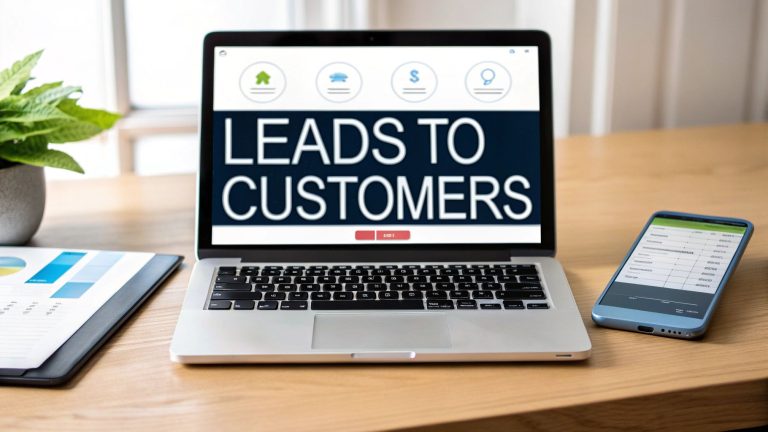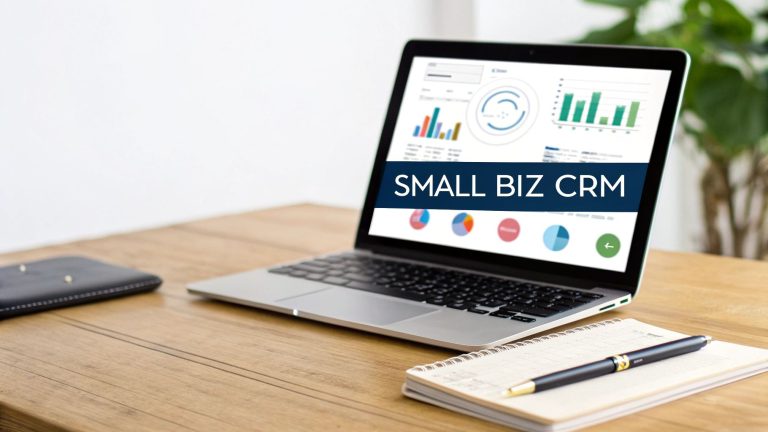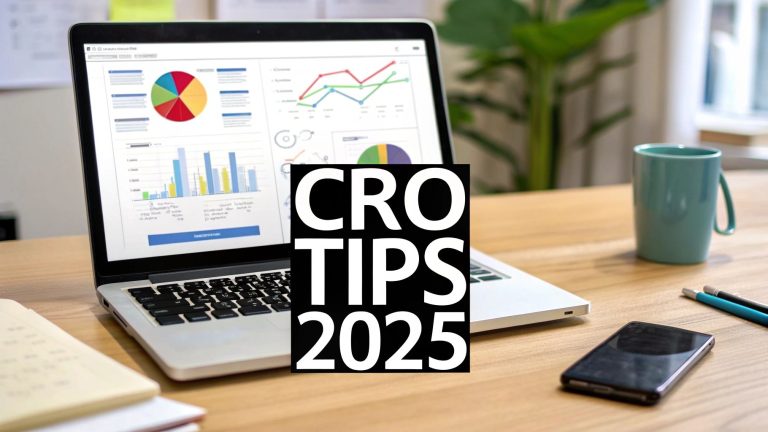What Is Conversion Tracking Explained Simply
Ever wondered if your ads are actually working? Conversion tracking is how you find out.
It’s the simple (but powerful) process of seeing what a user does after they interact with your ad or marketing campaign. It connects the dots between a click on a Google Ad and a real business result, like a product purchase. Without it, you're flying blind, only seeing half the story.
Decoding Digital Marketing Success
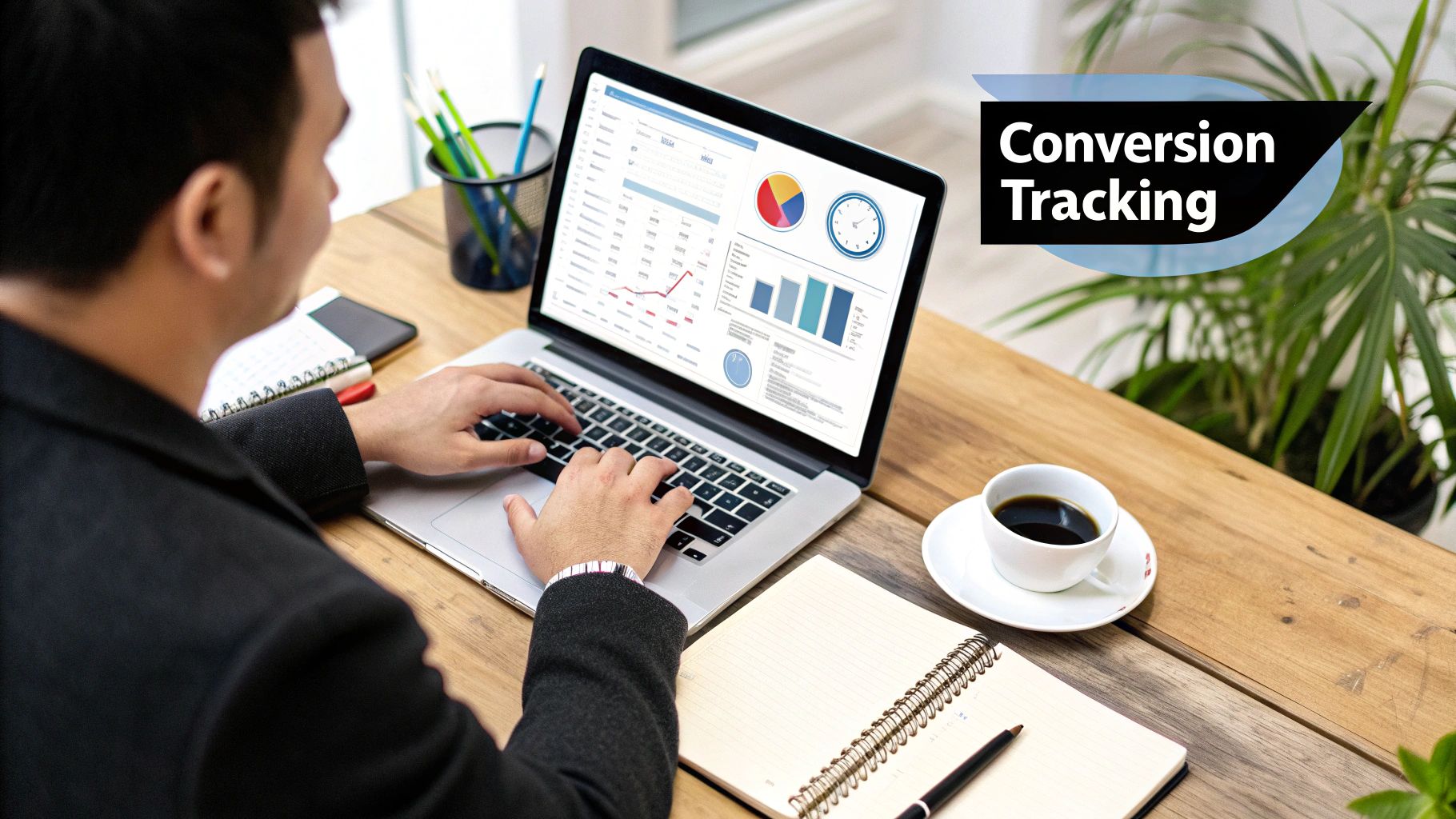
Think of your website like a brick-and-mortar store. Lots of people might wander in, browse the aisles, and leave without buying anything. That foot traffic is just like website clicks or ad impressions—it shows interest, but it doesn't pay the bills.
Now, what if you knew exactly which billboard or radio ad brought in the customers who actually bought something? That’s exactly what conversion tracking is for your online business.
It’s the bridge between someone seeing your Facebook ad and them pulling out their credit card. This is what moves you past vanity metrics like likes and shares, giving you hard proof of what really drives your bottom line. You stop wondering how many people saw your ad and start knowing how many people acted because of it.
From Educated Guesses to Hard Data
This need for clarity isn't new, but the tools we have are. Decades ago, businesses had to rely on clumsy methods like printing unique coupon codes in newspaper ads just to guess which campaigns were working. When the web took off in the 90s, we got click-through rates (CTR), which was a step up.
But it wasn't until the 2010s that direct conversion tracking became the bedrock of modern marketing. Today, with global e-commerce conversion rates hovering around a tight 2-3%, knowing your numbers is non-negotiable. You can learn more about how conversion rate trends have shifted over the years.
This leap from assumption to certainty is a game-changer. It lets you answer the big-money questions with total confidence:
- Which of my ad campaigns are actually making me money?
- Which keywords attract real buyers, not just window shoppers?
- Where should I put my marketing budget to get the best possible return?
By measuring these valuable actions, you turn your marketing from a hopeful expense into a predictable investment. You can confidently pour more money into what works and cut what doesn't, making sure every single dollar is pulling its weight.
Bottom line: conversion tracking isn't just some techy task. It's a strategic must-have. It’s the GPS that guides your business through the cluttered online world, pointing every decision toward real, profitable growth.
Without it, you're marketing with a blindfold on. With it, the path forward is crystal clear.
Why Conversion Tracking Drives Business Growth
Running a business without conversion tracking is like trying to find your way through a new city with a blindfold on. You might hear the sounds of traffic and sense people around you—that’s your impressions and clicks—but you have no idea which streets actually lead to where you want to go. You're just guessing where your money is going and hoping for the best.
Conversion tracking rips that blindfold off. It’s your GPS, giving you a crystal-clear, data-backed map that connects your marketing dollars directly to real business results. It turns marketing from an expensive guessing game into a predictable engine for growth.
Measure Your True Marketing ROI
The most obvious win from conversion tracking is figuring out your true Return On Investment (ROI). You can finally answer the biggest question in advertising: "Is this campaign actually making me money?"
Without it, you might see that you spent $1,000 on a campaign that got 500 clicks. Great, but then what? Did those clicks turn into $5,000 in sales, or just a bunch of people who bounced off your site a few seconds later? Tracking connects every dollar spent to the revenue it brings in, so you know for sure.
This kind of clarity first became a reality back in 2005 when Google Ads rolled out its conversion tracking tool. Before that, marketers were stuck with fuzzy metrics and a lot of assumptions. Suddenly, they could see exactly which ad clicks led to a sale or a sign-up, which completely changed how businesses measured success. If you're curious about the history, you can get more insights on how automation changed digital advertising on silverbackstrategies.com.
Unlock Deep Customer Insights
Beyond just counting sales, your conversion data tells a story about your customers. It reveals which messages hit home, which offers they can't resist, and the exact path they take before deciding to buy from you. This isn't just about numbers; it's a window into how your audience thinks and acts.
When you start digging into this data, you’ll uncover patterns that can shape your entire strategy:
- Campaign Performance: You might discover your "Summer Sale" video ad on Facebook is crushing your static image ads by a 3:1 ratio.
- Audience Preferences: You could learn that your audience in Texas converts at a way higher rate for a certain product than your audience in California.
- Landing Page Effectiveness: You might see that a landing page with a few customer testimonials gets a 25% higher conversion rate than one without.
This screenshot from Google Analytics shows a dashboard where you can see these user actions and conversions play out over time.
The chart gives you a clear look at trends in user activity and conversions, helping you spot which days or marketing efforts are actually working.
Enable Sharp, Data-Driven Optimization
Once you have accurate ROI and a handle on what your customers want, you can start fine-tuning your campaigns with surgical precision. Instead of making changes based on a gut feeling, you’re using hard data to make smart decisions that directly grow your bottom line.
Conversion tracking gives you the confidence to double down on what works and kill what doesn’t. It’s the difference between hoping for growth and actively engineering it.
Think about it this way: an e-commerce store sees one ad set has a fantastic Cost Per Acquisition (CPA) of $15, while another is costing them $60 per sale. They can confidently shift their budget from the loser to the winner, getting more sales without spending an extra dime. This constant loop of measuring, learning, and optimizing is the heart of building a sustainable business.
Understanding Your Most Valuable User Actions
When someone says “conversion,” your mind probably jumps straight to the final sale. That’s the big win, right? Absolutely. But if you only focus on that final transaction, you’re missing most of the story.
Effective conversion tracking is about seeing the entire customer journey, not just the destination. Many of the most valuable things a user does are the small, crucial steps they take before they're ready to buy.

To really get what conversion tracking is all about, you have to measure both the finish lines and all the milestones along the way. These actions are broken down into two simple categories that work hand-in-hand: macro-conversions and micro-conversions.
Macro-Conversions: The Ultimate Goals
A macro-conversion is your primary business goal. It’s the big kahuna, the action you really want users to take because it directly pumps revenue into your business.
Think of it as the touchdown in a football game—it's the whole point of the drive. These are the main events you track because they define success for your website or campaign.
Every business has a different "touchdown." For example:
- E-commerce: A completed purchase.
- B2B/Lead Gen: A submitted "Request a Demo" form.
- SaaS: A new paid subscription sign-up.
Tracking these macro-conversions is non-negotiable for calculating your return on ad spend (ROAS) and figuring out if your marketing is actually profitable. They give you the bottom-line answer: are my campaigns working or not?
Micro-Conversions: The Critical Stepping Stones
If macro-conversions are the destination, micro-conversions are the helpful signposts that guide people there. They are smaller actions that signal a user is getting more engaged and moving deeper into your world. In football terms, these are the first downs that keep the drive alive.
Tracking micro-conversions gives you a peek into the middle of the customer journey. It helps you understand how people are engaging and spot any roadblocks long before they decide to either buy or bounce.
Someone might not be ready to pull out their credit card today, but their actions can tell you they’re warming up. Getting a handle on how different touchpoints influence the final sale is key; you can explore an attribution model case study to see this in action.
Let's look at how these smaller steps build up to the main goal for different types of businesses.
Macro vs Micro Conversions by Business Type
This table breaks down the primary goals (macro) and the supporting actions (micro) that various online businesses should be tracking.
| Business Type | Example Macro-Conversion (Primary Goal) | Example Micro-Conversion (Supporting Action) |
|---|---|---|
| E-commerce | Completing a checkout | Adding an item to the cart or wishlist |
| SaaS | Starting a paid subscription | Signing up for a free trial or webinar |
| B2B | Submitting a qualified lead form | Downloading a case study or whitepaper |
| Blog/Publisher | Generating ad revenue | Subscribing to a newsletter |
By tracking both types of conversions, you get the complete narrative of your customer's journey. You can finally see which ads spark initial interest (micro-conversions) and which ones are actually closing the deals (macro-conversions).
This complete picture is what allows you to optimize every single stage of your funnel for maximum impact.
How the Technology Behind Tracking Works
So, how does this all actually work? To really get what conversion tracking is, you have to peek under the hood. It sounds super technical, but the basic idea is surprisingly simple.
Think of it like leaving a trail of digital breadcrumbs.
When someone clicks one of your ads—let's say on Google or Facebook—their browser gets a tiny piece of data called a cookie. This cookie is the first breadcrumb. It’s not personal info, just a unique, anonymous tag that says, “Hey, this person came from Ad Campaign #123.”
That person then starts exploring your website. Maybe they check out a product page, read a blog post, or look at your pricing. All the while, that little breadcrumb (the cookie) is stored temporarily in their browser, just waiting.
The Key Players in Conversion Tracking
The magic really happens when they do what you wanted them to do—like filling out a form or buying something. This usually takes them to a "Thank You" or confirmation page, and this page is special. It's armed with another piece of tech: the tracking pixel.
Here are the moving parts:
- The Tracking Pixel: This is just a tiny, invisible snippet of code you place on your conversion page. When the page loads for a new customer, the pixel "fires" (activates).
- The Cookie: This is that digital breadcrumb left on the person’s browser when they first clicked your ad.
- The Conversion Page: This is the destination, like your "Thank You" page, that confirms a successful action.
When the tracking pixel fires, its one job is to look for that breadcrumb. It quickly scans the user's browser for the specific cookie left by your ad campaign. If it finds a match, it shoots a message back to the ad platform (like Google Ads or Facebook Ads) that says, "Success! The person from Ad Campaign #123 just completed the goal!"
Setting this up is a fundamental part of running ads. This infographic breaks down the core steps involved in getting your tracking system off the ground.
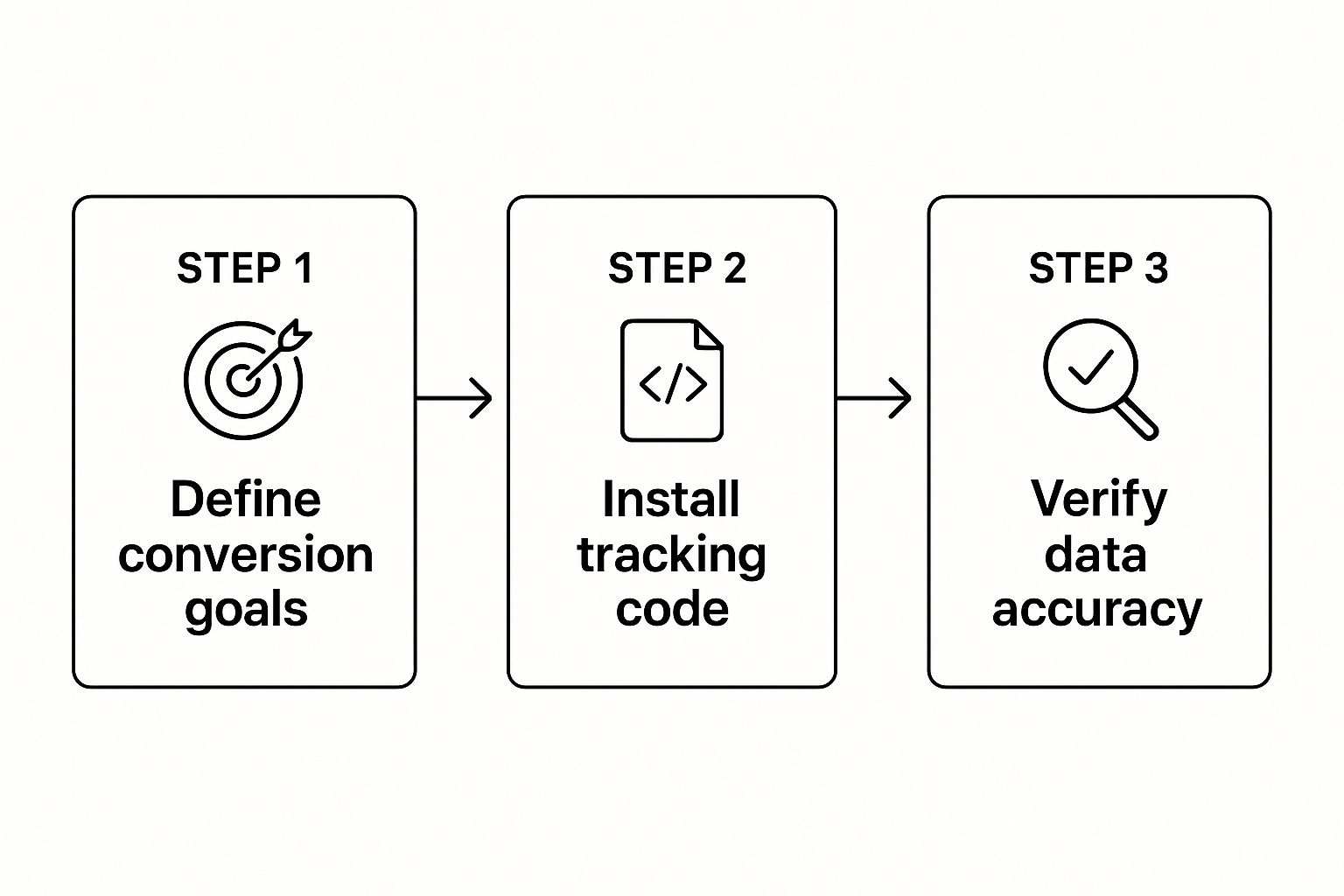
As you can see, solid tracking isn't just about code; it's a strategic process that starts with knowing exactly what you want to achieve.
Client-Side vs. Server-Side Tracking
The breadcrumb method we just walked through is called client-side tracking. It relies entirely on the user's browser (the "client") to hold the cookie and fire the pixel. For years, this was the go-to method. It’s pretty straightforward to set up and works fine for many basic situations. For a deep dive into how this looks on a specific platform, our guide on Facebook Ads conversion tracking gives you a step-by-step walkthrough.
But things are changing. With ad blockers, new privacy rules, and browsers ditching third-party cookies, client-side tracking is becoming less reliable. Ad blockers can stop the pixel from firing, and cookie restrictions can erase the breadcrumb trail. The result? Lost data and inaccurate reporting.
This is where a much tougher method comes in: server-side tracking. Instead of depending on the user's browser, the conversion data is sent directly from your website's server to the ad platform's server.
Here’s an easy way to think about it:
- Client-Side: Your website asks the user's browser, "Hey, could you please tell Facebook a sale happened?"
- Server-Side: Your website's server directly tells Facebook's server, "A sale just happened."
This direct, server-to-server chat is way more durable. It can't be shut down by browser settings or ad blockers, which means you get more accurate and complete data. While it's a bit more technical to set up, server-side tracking is quickly becoming the new standard for anyone who needs rock-solid data in a privacy-focused world.
Key Metrics That Measure Real Success
Tracking conversions is a massive leap forward, but just counting them only gives you part of the picture. A campaign with 100 conversions sounds incredible, right? But not if you find out it cost you twice what those sales are actually worth.
To really know if your marketing is working, you need to look past the raw numbers. It's all about focusing on the key metrics that measure efficiency and, most importantly, profitability. These are the KPIs that turn conversion data into real, actionable intelligence. They show you not just what happened, but how much it cost and how much you earned.
This is what separates guessing from knowing.
Conversion Rate: The Foundation of Efficiency
Your Conversion Rate is probably the most fundamental metric in your entire toolkit. It tells you exactly what percentage of people who click your ad or visit your website are actually taking the action you want them to take. It's the ultimate report card on how persuasive your offer and landing page really are.
The formula is super simple:
(Total Conversions / Total Visitors or Clicks) x 100 = Conversion Rate (%)
For example, if an ad drives 1,000 visitors to your landing page and 50 of them buy something, your conversion rate is a solid 5%. This number is your efficiency baseline. While getting more traffic is great, the conversion rate gives you crucial context. A site with 10,000 visitors and 300 conversions has a 3% conversion rate. If you double your traffic to 20,000 visitors but conversions stay at 300, your rate plummets to 1.5%. That's a huge red flag that something is wrong, even though your traffic went up.
By focusing on improving your conversion rate, you can generate more sales from the exact same amount of traffic. It's the key to making every visitor count.
Cost Per Acquisition: How Much Does a Customer Cost?
Next up is Cost Per Acquisition (CPA), sometimes called Cost Per Conversion. This metric answers one of the most important questions you can ask: how much money are you spending to get one new customer or lead? It directly connects your ad spend to a single, tangible result.
Here’s how you calculate it:
Total Ad Spend / Total Conversions = CPA
So, if you spend $500 on a Google Ads campaign and get 25 new leads, your CPA is $20. Knowing this number is critical for managing your budget. A low CPA means your marketing is efficient. A high CPA can drain your bank account in a hurry, even if you're technically getting a lot of conversions. To really get a handle on the financial side of things, it helps to understand the different ad cost models, and this resource offers a great breakdown of understanding the differences between CPC, CPM, and CPA.
Return On Ad Spend: The Ultimate Profitability Metric
Finally, we arrive at the metric every business owner and CFO truly cares about: Return On Ad Spend (ROAS). While CPA tells you the cost, ROAS tells you about the revenue. It measures exactly how much money you make for every single dollar you put into advertising.
The formula is straightforward:
Total Revenue from Ads / Total Ad Spend = ROAS
Let's say you spend $1,000 on Facebook ads and generate $4,000 in sales from them. Your ROAS is 4:1, meaning you earned $4 for every $1 you spent. This is the ultimate test of whether your ads are actually profitable. A campaign could have a fantastic conversion rate and a decent CPA, but if the ROAS is below 1:1, you are actively losing money. For a more detailed guide, check out our article on how to calculate Return on Ad Spend.
By balancing these three metrics, you get a complete picture of your campaign’s health. It allows you to stop guessing and start making smart decisions that drive what truly matters—profitable, sustainable growth.
Actionable Best Practices for Accurate Tracking
Setting up conversion tracking is a huge step, but just flipping the switch isn't the end of the story. The real goal isn't just to gather data; it's to gather clean, accurate, and trustworthy data. Without that solid foundation, your reports can easily lead you down the wrong path, causing you to make bad decisions that burn through your time and budget.
Think of it like building a house. You wouldn't just dump a pile of bricks and hope it turns into a home. You need a solid blueprint and careful construction to make sure the final structure is sound. The same logic applies here. These best practices are your blueprint for building a tracking system you can actually rely on.
Following these steps ensures every conversion metric you look at reflects what’s really happening. This accuracy is what gives you the confidence to double down on what's working and fine-tune your entire marketing strategy for the best possible results.
Systemize Your Tracking with a Tag Manager
Trying to manage dozens of tracking codes directly on your website is a recipe for disaster. One tiny coding mistake can bring your site down, and keeping everything updated becomes a real nightmare. This is where a tag management system like Google Tag Manager (GTM) saves the day.
Instead of jamming individual tracking pixels from Google, Facebook, and other platforms directly into your site’s code, you just install the GTM container once. From there, you can manage all your other tags from GTM’s clean, easy-to-use interface.
This approach gives you a few major wins:
- Organization: It keeps all your tracking scripts neatly filed in one place, preventing a mess of code.
- Safety: You can test any changes in a "Preview" mode before you push them live, which drastically cuts down the risk of breaking your site.
- Speed: Rolling out new tracking tags takes minutes, not hours of waiting for a developer to get to it.
Think of Google Tag Manager as a digital toolbox for all your tracking codes. It keeps everything neat, accessible, and easy to handle, so you can focus on the data instead of getting tangled in code.
Validate and Test Your Setup Rigorously
Never just assume your tracking is working because you installed the code. You have to test it, and test it again. It's non-negotiable. Use tools like the Google Tag Assistant or the Facebook Events Manager Test Events tool to confirm that your tags are actually firing when a conversion happens.
Walk through the entire conversion process yourself. Click a live test ad, land on your page, and complete the action you want to track. Then, pop over to your ad platforms and see if the conversion was recorded. It's important to confirm this within 24 hours, as that’s often how long it takes for new conversion actions to switch to "Active."
This step is so critical because it helps you catch problems before they snowball. A broken trigger or an incorrect conversion value can poison weeks of data, so spending a few minutes testing now will save you from massive headaches later on.
Capture the Complete Customer Journey
Today’s customer journey is all over the place. Someone might see your ad on their phone during their morning commute, research your product on their work laptop, and finally buy it on their tablet at home that night. If you’re only tracking conversions on a single device, you’re missing the big picture.
Implementing cross-device tracking is essential to understand how all these different touchpoints work together to land a sale. Ad platforms like Google and Facebook use signals from signed-in users to connect the dots across multiple devices. This gives you a much more complete view, helping you attribute conversions where they're actually due.
On top of that, following proper data management best practices is key to keeping your information clean across all these touchpoints. This ensures the data you collect is consistent and reliable, no matter where it came from.
Finally, pick an attribution model that actually fits your business. "Last-click" attribution gives 100% of the credit to the final touchpoint, completely ignoring all the earlier steps that got the customer there. Models like "linear" or "data-driven" spread the credit more evenly, giving you a far more accurate picture of which channels are truly driving value from start to finish.
Frequently Asked Questions About Conversion Tracking
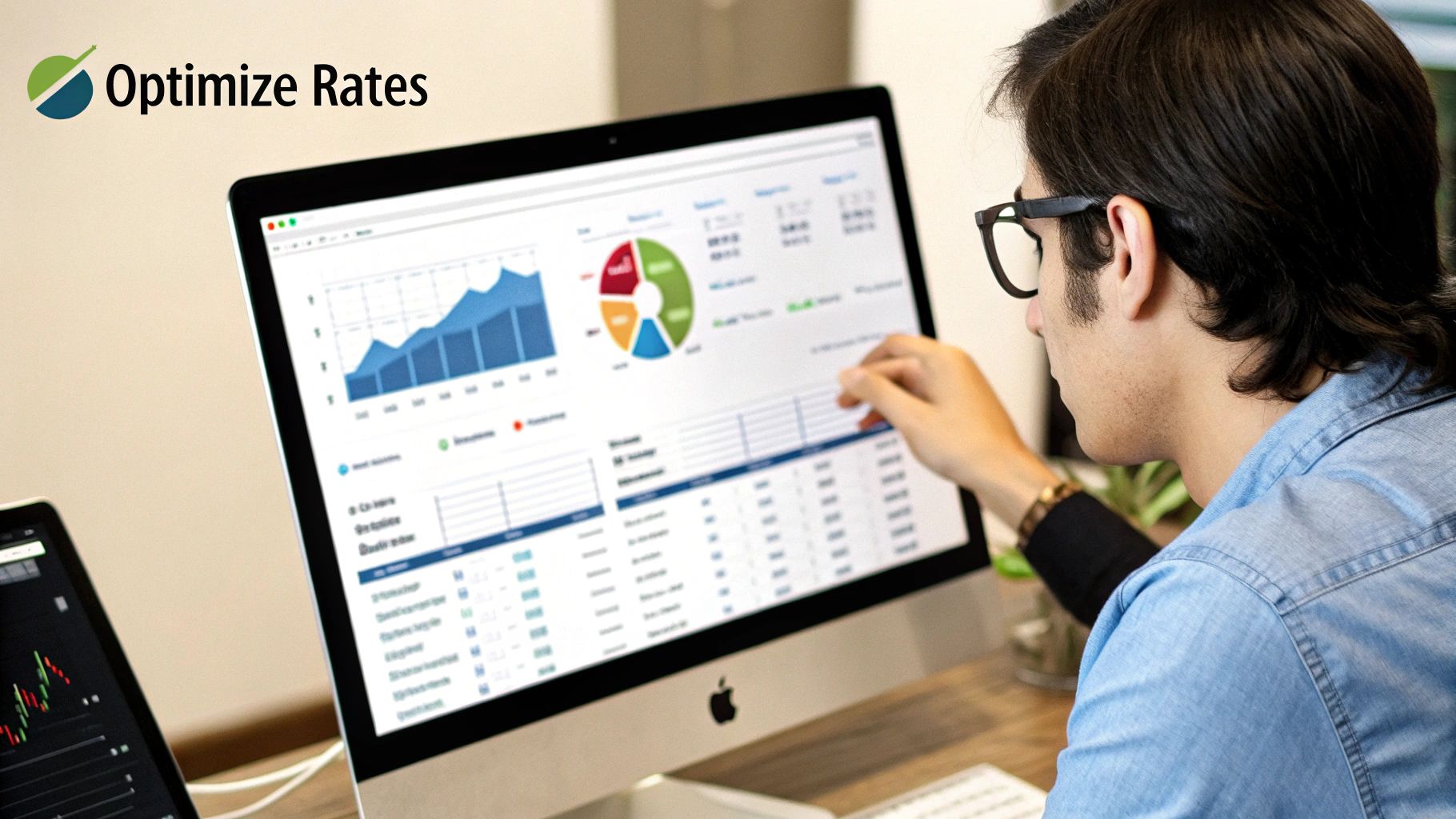
Even after covering the basics, a few common questions always pop up. Let's tackle them head-on to clear up any lingering confusion and get you ready to track like a pro.
What Is the Difference Between Conversion Tracking and Web Analytics
It's a great question, and the easiest way to think about it is with a camera analogy.
Web analytics, like what you get from Google Analytics, is your wide-angle lens. It gives you the big picture of everything happening on your site—where people are coming from, what pages they're browsing, and how long they stick around. It answers the broad question: "What are people doing?"
Conversion tracking, however, is your zoom lens. It locks onto the specific, high-value actions you care about most. It answers the much more important question: "Did my ads get people to do the one thing I wanted them to do?"
Can I Track Conversions Without a Thank You Page
Absolutely. The classic "Thank You" page is a simple and reliable method, but it’s definitely not the only game in town. Modern websites and apps are full of important actions that don't involve loading a whole new page.
This is where event-based tracking comes in.
Using a tool like Google Tag Manager, you can set up a conversion "event" that fires whenever a user takes a specific action, like:
- Clicking a "Submit Form" or "Download PDF" button.
- Watching a certain percentage of a video.
- Interacting with a key feature on your web app.
This approach gives you way more flexibility and is pretty much essential for tracking engagement on today's dynamic, single-page websites.
How Do Privacy Changes Affect Conversion Tracking
This is the big one. Privacy updates, ad blockers, and the slow death of third-party cookies are shaking things up for marketers. These changes can block the tracking pixels we’ve relied on for years, breaking that digital breadcrumb trail and leaving massive holes in your data.
This shift is precisely why so many businesses are now moving toward server-side tracking. It’s a more durable and privacy-conscious solution built for the modern web.
Instead of relying on the user's browser to report a conversion, this method sends the data directly from your website's server to the ad platform's server. It's a much more reliable line of communication that can't be easily blocked by browsers or ad-blocking software.
The result? You get more accurate data while also respecting user privacy. Answering what is conversion tracking today means adapting to these smarter, more robust technologies.
Ready to stop wrestling with manual lead downloads and start converting customers faster? LeadSavvy Pro automates your entire Facebook lead capture process, sending new leads directly to your Google Sheet or CRM in real-time. Try it for free and see how simple lead management can be. Get started with LeadSavvy Pro today.


